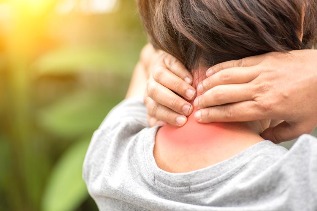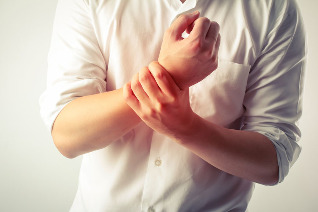Osteochondrosis and a disease that in one of the most popular in the world. The majority of the people, original works of art for 35 years, have osteochondrosis of the cervical spine in one form or another. Recently there has been a tendency to increase the number of suffering from a form of severe the disease and the rejuvenation of the disease, reduce its part lower limit of age. This and due to the fact that a growing number of people all over the world engaged in sedentary work and a sedentary lifestyle. Meanwhile, the disease is very dangerous, and everyone should know that and low back pain, how it manifests and how it is taken care of, to be able to recognize the symptoms and point from the start of treatment.

Causes of cervical degenerative disk disease
Low back pain, one of the few diseases that are only for the specific human beings. In other animals the disease is not found. The reason d and shot this the distinctive of being human as walking upright. Vertical position of the spine vertebrae causes the other against the press and the osteochondral tissue of the vertebral column a little a little degraded and deformed. The spine the human begins with the cervical. All in this Department seven vertebrae from the first to the seventh. The vertebrae are separated from each other, and intervertebral discs. The cervical spine and vulnerable, especially a part of him that is connected, mainly, with the object the enlargement of the mobility of the vertebrae in this region. In the neck of the uterus disease is reflected primarily in the clubs, that are of the un weak point in the structure of the spine. The prevalence of cervical degenerative disc disease also contribute to such factors as the small size of the vertebrae and the relative weakness of the muscles of the neck. The development of cervical degenerative disc is a disease that is highly influenced by the lack of blood supply to cartilage. Therefore, the development of the disease is complex and a long process and not have a single cause. Although the relationship between sedentary work and the presence of cervical degenerative disc disease, however, it is usually the disease in to find trained people, especially athletes due to the increase on the load of the cervical spine in lifting weights. In the elderly, as a general rule, the degradation of the structures vertebral and a process inevitable associat with l and the weakening ageing of its protection forces. However, the more Marta pathological types of cervical degenerative disc disease, in which the main role externs interns or negative factors.
The factors that contribute to the development of degenerative disc disease of the neck:
- The position of the
- The curvature of the spine
- A back injury
- The excess weight
- Heavy physical work
- Sedentary work
- The un sedentary lifestyle
- The un process metabolic
- Frequent hypothermia
- A posture uncomfortable during the son
- Stress, fatigue
- Hereditary Factors
- Infectious diseases
- The individuals and The characteristics of the body structure, for example, too long or too short neck
The degree of development of cervical degenerative disc disease
The disease has four stages. Not always easy to determine the stage of the disease, based on the analysis of the symptoms, because sometimes, the degree of degradation of the bone and cartilage tissue may not match the symptoms to the that experienced by the patient.

First grade
Start the processes in destructive bone cartilage and tissue of the vertebrae. Normally, at this stage of the of the cervical osteochondrosis symptoms are mild. Sick or not n will notice them or associated with diseases of the spine and a l s attributes to stress and overwork.
Second degree
Starts to decrease a record of the"height of the surface its cracks. The symptoms of cervical degenerative disc disease at this stage is manifested in constante pain, weakness, lack of sensitivity of certain areas of the face.
Third grade
Formed from herniated discs, damaged cervical vessels and muscles. Appears In a patient dizziness, pain in the back of the head.
The fourth grade
Appear osteophytes – growth of bone tissue that protects the vertebrae of the load, which leads to a pinched piegaro. This brings us to the rigidity of an extremity damage les and the joints adjacent.
Cervical degenerative disc disease: symptoms
Early symptoms of osteochondrosis of the cervical spine:
- Pain in the neck and shoulders
- Muscle weakness
- Excessive sweating
- Sensation of numbness in the hands
- Impairment of coordination
- Dizziness
- Blurred vision and hearing
- Increase in blood pressure
- Headaches
These are typical of degenerative disk disease of the cervical spine the symptoms that may be present in all stages of the disease. In the majority of cases observed some of the symptoms of the list, and the other missing People may be the first time you are faced with these signs of disease is not always suspected myself of cervical osteochondrosis. So that you can appeal to a variety of therapists, cardiologists, neurologists, surgeons. I diagnosis correct result can be delivered with a significant delay.

Syndromes
With cervical osteochondrosis there are some syndromes that a typical of States with a set of characteristic features. Appear as the and the piegaro arteries are affected a result as a disease d':
- artery vertebral syndrome
- syndrome cardiac
- syndrome hypertensive
- syndrome radicular
- syndrome cervical migraine
Artery Vertebral and syndrome, one of the most dangerous and complications unpleasant of cervical osteochondrosis. A because it reduces the flow of blood through the arteries that pass along the spine to feed the brain. The syndrome is manifested in symptoms such as systemic or recurrent vertigo, decreased hearing and vision. In some cases, the pot more faint. Often there is a kind of syndrome to conclude that, in conditions is a condition the blood flow in the arteries, and normal, however, when turning the head to any direction that may fall sharply. Syndrome Heart disease is the develops when compression of the nerve roots carrying the innervation of the diaphragm or the chest muscles. As a result, the patient may experience pain, reminiscent of the cardialgia, although direct effects on the heart during this procedure. However, the syndrome is characterized by such effects as tachycardia, hypotension and arrhythmia. Syndrome Hypertensive also is among the most dangerous complications. On the other hand, the artery spinal and syndrome caused by the compression of any arteries and veins that hinders the blood circulation of the head. The syndrome leads to un increase in intracranial pressure, which can manifest in symptoms such as nausea, vomiting, headache. Syndrome cervical migraine has little, Marta, in their etiology with the classic migraine. It manifests itself in a sharp pain in the back of the head. Pains are paroxysmal in nature with a duration of up to ten hours and was accompanied by vomiting. Les, and the syndrome is more common in the syndrome of osteochondrosis of the neck of the uterus. And caused by the compression of the individual to the nerve roots cervical vertebrae. Can be the pain in the neck, the neck, shoulders, back, numbness and a weakening of the key individuals of the sections of the hands (inability to manipulation of make any), and the neck. Very often can be observed in destinations syndromes or symptoms individuals associated with different syndromes. As you can see, osteochondrosis of the cervical spine manifestations of the disease versatile and are not always patient and able to detect correctly the reason of its occurrence. If you are facing similar symptoms, and the cause to seek medical attention.

Diagnosis
For the diagnosis it is recommended to consult the un therapist. He will give a referral to orthopedic, spine, neurologist. For diagnosis, the following types of studies:
- The x-ray of
- Computed tomography
- Magnetic image
- Scan Ultrasound of neck vessels
The two rays X allows to determine the displacement of the vertebrae, the presence of growths – osteophytes and salt deposits, the seals, the discs. Computed tomography to create a series of two rays x, giving a representation of the body three-dimensional, in this case, of the cervical spine. Allows you to specify the degree of the pathological process of the nature of the compression of piegaro, the structure of osteophytes, disc'height, etc. magnetic Resonance imaging based on the physical effect of nuclear magnetic resonance, explanation gives an image more detailed structure of the spine. Ultrasound of neck vessels helps to identify the changes in the blood flow vessels in the great neck caused by the disease.
Treatment of cervical degenerative disk disease at home
Osteochondrosis How to treat the cervical spine in a home and treated, if necessary? In order to combat the disease, the medicine has developed many methods. Treatments Some that you can use at home. However, this process is long-lasting and complete healing and unlikely, especially in the elderly. However, to slow down and destructive to stop the processes in the spine can, at any stage of the disease. In the initial stages of the disease methods tend to be conservative. For the treatment of cervical degenerative disc s used disease of destinations ways:
- Drugs
- Physiotherapy
- Physical therapy
- Massage
- Special Means for the fixation of the spine
If the disease progressed to the last stage, and there is destruction serious of the bone and cartilage structures of the spine, for the treatment of degenerative disc disease of the cervical spine can be used and surgery.
Drugs
The following types of drugs:
- Chondroprotectors
- Vitamins
- Analgesics
- Anti-inflammatory drugs
- Antispasmodics such

Acute pain syndrome osteochondrosis associat with the first priority and the removal. Usually s use drugs oral, such as Dipyrone or Baralgin, however, its ineffectiveness in severe cases, used novocaine blockade. For muscle cramps apply antispasmodics such. The greater efficiency in demonstrating osteochondrosis created with this disease against the drug, although the use of other muscle relaxants. As anti-inflammatories and pain relievers can be used ointments that do not contain steroids drugs. With the presence of the syndrome associated with the circulation of the blood and blood supply to the brain – hypertensive and artery vertebral syndrome, taking drugs, eliminating the unwanted effects of these syndromes – decrease the pressure and nootropic agents.
Physiotherapy
The physiotherapy and the more easy and affordable form of treatment of cervical degenerative disc disease and, at the same time, very sure. Treatment exercise you can do at home. In osteochondrosis of the intensity of the formacio and not critical, only the frequency. In the first place, the physical education is designed to strengthen the neck muscles that make up for the lack of functionality of the spine and help support the weakened vertebrae. Strengthen the muscles of the neck, are recommended activities of daily living. It can be very simple, composed of rotations and s tilt the head in different directions, and the more complex, even using the neck muscles of the hands. You can make as much as a house to work. For example, if the work and sedentary, and useful for making these original works of art of exercises in an hour of sitting at a table or a monitor. However, to meet them, just outside the period of exacerbation and in the absence of pain. Otherwise, they can only worsen the condition. I reinforce effective Equally the muscles of the shoulder girdle, for example, with the help of regular exercise with light weights. However, the heavy lifting (kettlebells, barbells) is contraindicated. Also, regular useful for swimming reduces the load on the spine.
Physical therapy
Physical therapy – method of treatment using the body effects on some of the fields in physics and radiation. Positive The quality of the therapy physics in that there are un minimum number of contraindications. For the treatment of degenerative disc disease, the following methods of physiotherapy:
- Ultrasonic impact
- Laser therapy
- The influence of the magnetic field
- The influence of the electric current (electrophoresis)
The magnetic field is un positive effect damage in the tissues of the body and has anti-inflammatory and analgesic effect. Ultrasound improves the metabolic processes in the tissues, reduces inflammation. The same can be said about laser therapy. Electrophoresis most often s used in combination with drugs, since the use of electric current accelerates the absorption of the body.

Massage
Massage reduces the increase muscle, causing spasms and decreases the flow of lymph, causing inflammation. The procedure promotes improved circulation in the affected area, which stops the process of destruction of intervertebral discs.
Other treatments
What to do in cervical osteochondrosis if the classical methods of treatment at home without help? To reduce the load on the neck of the uterus special device from the neck of a Trench, which connects the neck in a constant normal position. It is recommended to bring during the exacerbations of pain or prolonged sedentary work. In order to avoid examining a relapse, also s must arrange a place to sleep. The pillow should not cause curvature of the neck, and the mattress should be rigid and smooth. In some cases, can help special sleep – mattress and pillow.
































